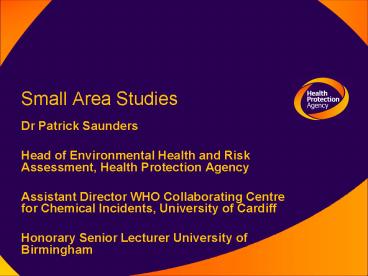Small Area Studies - PowerPoint PPT Presentation
1 / 13
Title:
Small Area Studies
Description:
Studies of the association between residential proximity to a potential source ... Saunders PJ, Kibble, AJ, Burls, A. 2006. Investigating alleged clusters. ... – PowerPoint PPT presentation
Number of Views:22
Avg rating:3.0/5.0
Title: Small Area Studies
1
Small Area Studies
- Dr Patrick Saunders
- Head of Environmental Health and Risk Assessment,
Health Protection Agency - Assistant Director WHO Collaborating Centre for
Chemical Incidents, University of Cardiff - Honorary Senior Lecturer University of Birmingham
2
Introduction
- What they are
- The problems associated with them
- Guidance on when and how to conduct them
- My role
- advise the HPA
- produce guidance for the WHO
- published guidance in Oxford Handbook
3
Introduction
- Studies of the association between residential
proximity to a potential source of pollution and
increased levels of some disease(s) - In response to concerns about an elevated level
of disease AND/OR elevated level of exposure - There are serious issues about the worth and
appropriateness of such studies in the great
majority of cases - This is the case internationally-range of
guidance has been developed
4
Issues
- Many sophisticated methods for investigation but
they are all founded on same basic statistical
principles and prone to error - Type 1 error-appears to be an excess of disease,
or to be an association between exposure and
disease, when in fact no causal relationship
exists - Type 2 error occurs when no statistical
association is found, but a causal relationship
exists
5
Issues
- Randomness
- Exposure misclassification
- Plausibility
- Confounders
- Statistical power/techniques
6
Randomness
7
Statistical Issues
- An even more serious problem with some surveys
of leukaemia is a tendency to draw the
boundaries after seeing the data. It is
essential to draw all boundaries (in space, time,
age group and type of disease) before conducting
the survey. Otherwise it is easy to create
highly improbable incidences by choosing tight
boundaries around apparent clusters. Studies
by people who are not aware of the problem can
lead to apparently frightening results. The New
Scientist
8
Exposure misclassification
- Next biggest problem
- virtually no study uses actual exposure data
- difficult to obtain such data
- most use distance as simple proxy for exposure
- takes no account of the impact of weather,
topography, technical factors - can use modelling to refine
- Takes no account of personal behaviour
9
Plausibility
- Temporal
- Precedes exposure?
- Population movement-time of diagnosis not
necessarily the same as exposure/illness - Spatial-downwind or upwind?
- Biological
- Most diseases have several causes
- Is the condition plausibly associated with the
exposure? - Is the condition real and/or the correct one?
10
Confounders
- Other things could cause/influence the disease in
question - Age
- Gender
- Genetics
- Other exposures e.g. occupational
- Deprivation
- Smoking
- Drinking
11
Statistical Issues
- Multiple testing/95 confidence intervals
- Type 1 error is more likely if multiple
statistical tests are performed. By definition,
one would expect to find P lt 0.05 in 1 in 20
significance tests, even if no causal
relationship exists. If one performs 10 tests,
then there is a 40 chance that at least one
would be significant at the 5 level - Small numbers
- Type 2 error may result from flawed disease or
exposure data, or inappropriate study design. The
commonest reason, however, is insufficient
statistical powerthe cases are just too rare. It
may be impossible, for example, to know whether
three cases of a rare disease in a population of
workers really is excessive
12
Guidance
- The reported experience of health agencies
confirms that major associations between
exposures and outcomes are rare. Minnesota, for
example, has reported results from over 500
investigations of clusters, six of which were
full-scale investigations. In one instance, in an
occupational setting, an important public health
outcome was documented - Saunders PJ, Kibble, AJ, Burls, A. 2006.
Investigating alleged clusters. In Oxford
Handbook of Public Health Practice, 2nd edition.
(Pencheon D, Melzer D, Gray M, Guest C, Eds).
Oxford University Press, Oxford.
13
Guidance
- If there is an exceedence of a health based
standard-address it - If there is a statutory nuisance-abate it
- If there is an excess of disease-investigate it
- Single site study only if there is plausibility
- environmental, biological, spatial and temporal









![Area and Volume [I] PowerPoint PPT Presentation](https://s3.amazonaws.com/images.powershow.com/7947695.th0.jpg?_=20160702019)





















